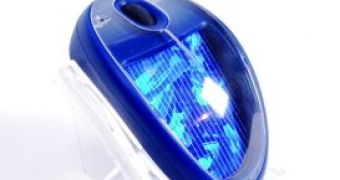Wireless mice are all too common nowadays in a computing environment that is more and more centered on mobility. The main drawback of most such wireless mice is that after a few days at most the batteries must be changed, or if rechargeable units are used they must be left several hours to replenish their energy levels.
While this is not even on the list of top annoyances that plague computer users, a group of Dutch researchers went out and played with the idea of a wireless mouse that does not need a new power source every few days. What they came back with is the first solar powered mouse. This seems a good idea for those users that are not using a wireless model too, even if the humble computer mouse is at the very bottom of energy consumption in a computer system.
Named the "Sole Mio" this mouse is using solar power (hey, that free!) to recharge a small battery pack when it is not in use. According to the design team that built it, the solar powered mouse should have enough energy to work a full day in an office environment. In order to test and promote their invention, the group of Dutch researchers convinced Minister Cramer of the Ministry for Housing, Spatial Planning and the Environment to take part in a user trial. Sole Mio was designed as a part of the Syn-Energy program sponsored by the Netherlands Organisation for Scientific Research, with the cooperation of the universities of Twente and Utrecht.
The Sole Mio mouse design is aimed at an office user with access to natural light that is partially augmented by artificial light as the solar power mouse must be regularly recharged by placing it near a window. Under ideal conditions, solar recharging should take up to five times less time than in an office or when using only artificial light. According to the TU Delft Industrial Design Engineering Faculty that helped create this mouse, its widespread adoption and use could mean that "several hundred million batteries could be saved annually on a global scale".
Even if the photovoltaic-powered (PV for short) mouse will not make a tremendous impact because of the "the high energy content of current PV cells", it is hoped that in the near future a new type of PV cell will be introduced, being cheaper to produce and storing more solar energy. The solar mouse that was given to Minister Cramer to test is one of a very limited test-intended series of only 15 units, the design team hoping to show that renewable energy products are viable options to the more traditional designs, while offering a similar or higher functionality and attractive form.

 14 DAY TRIAL //
14 DAY TRIAL //